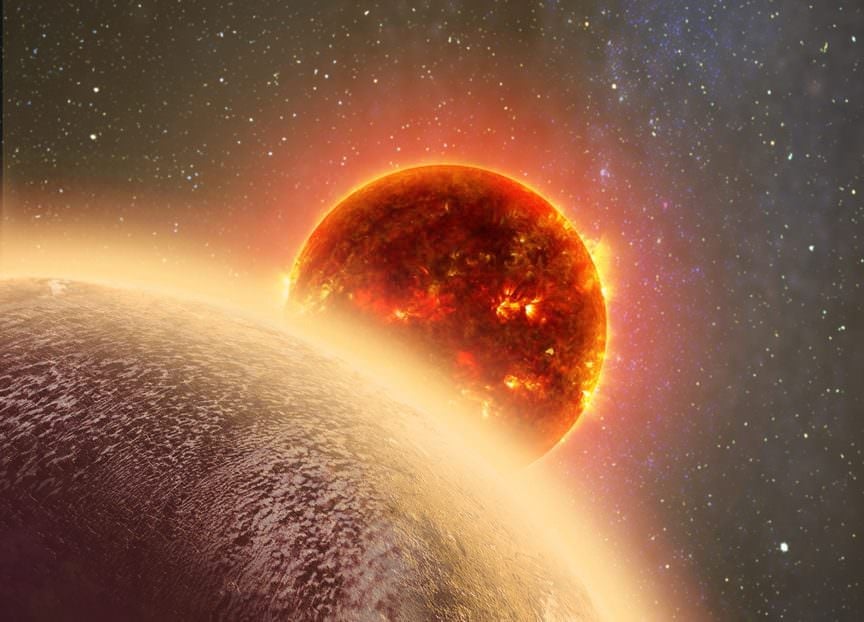Astronomers sometimes find conflicting data when trying to answer a question. This is a normal part of the scientific process, and it simply means that more data is needed to prove or disprove the theory they are trying to test. One prominent example of conflicting data in recent exoplanet research was that of planet GJ 1132 b, which either had or didn’t have an atmosphere, depending on which data set was being used. A new paper from researchers using more observational time on the James Webb Space Telescope (JWST) can now definitively say that, most likely, GJ 1132 b doesn’t have an atmosphere – and that finding has wider implications for exoplanet research more generally.
GJ 1132 b is located around a M-dwarf star around 41 light years away. It has attracted a lot of attention because it looks a lot like Earth in some ways, and in other ways it is completely alien. It’s rocky, with a radius and mass only slightly larger than Earth’s. However, it is located .0153 AU away from its host star, and orbits it every 1.6 days. Given this close proximity, it might be surprising that any atmosphere would exist at all, but there are some models that show planets even that close to their M-dwarf parent stars could potentially hold on to an atmosphere. This is an important question, since M-dwarfs are very active, with high radiation and flaring, both of which are thought to strip planets of their atmospheres. In response to this, astronomers have developed the concept of a “cosmic shoreline”, of irradiation and planet size, beyond which planets can’t hold on to their atmospheres.
This paper wades straight into that argument, and actually represents an update to a previous paper, where two original transits observed with JWST showed conflicting data about the presence of an atmosphere on GJ 1132 b. One transit implied the planet had a water-rich atmosphere, the second implied that it had none. The new study looked at two additional transits of the planet, and that additional data shows the planet most likely doesn’t have an atmosphere.
Artist’s impression of GJ 1132 b – which now should be updated given its definitive lack of atmosphere. Credit – SciTech Daily YouTube Channel
There is still room in the data for the possibility of a very low pressure (around 1 mbar) “steam” atmosphere, but most astronomers think that is not possible for this particular planet, given the proximity to its star and its seeming lack of water, which was noted in previous JWST studies. Importantly, even that possibility goes away almost completely if the first data set (i.e. the one pointing to a water atmosphere) isn’t used in the analysis – meaning three other data sets agree that GJ 1132 b doesn’t have an atmosphere.
Once they realized that, the authors went back to look at what might have made the first data set so out of line with the other three. When looking at the star itself, it became clear that there were more “cool spots” on the star’s surface than during the other three transits, which influenced the data collected about the planet itself. The authors believe that might have been what made it look like the planet had an atmosphere in one dataset, when it really didn’t. As part of this finding, the authors suggest using a “leave-one-out” approach for exoplanet datasets when more than one is available, especially if the star is highly variable.
Another important feature of this paper is the methods used to collect the data. It used two different viewing modes of the NIRSpec instrument onboard JWST – G395H and G395M. G395H is higher resolution, whereas the G395M viewing mode is “medium” resolution. The trade-off is that the G395H mode has a “gap” in its data between 3.75um and 3.82 um, which could influence the data. However, the authors found this wasn’t a problem, with the noise comparable between the two modes. Their recommendation is to use the medium resolution mode if only capturing one exoplanet transit, but it’s probably safe to just use the high resolution mode if allotted time for more than one.
Fraser discusses exoplanet atmospheres with Dr. Joanna Barstow
Ultimately, this paper pretty clearly puts to rest the idea that GJ 1132 b has an atmosphere – especially any sort of thick one. It also offers solutions for making sure the kind of confusion that happened for this particular planet doesn’t happen again in other studies of exoplanet atmospheres. But perhaps most importantly, it is another data point in the ongoing debate about whether planets around M-dwarf stars can hold on to their atmospheres – and it appears to firmly support the idea that they can’t.
Learn More:
K. A. Bennett et al – Additional JWST/NIRSpec Transits of the Rocky M Dwarf Exoplanet GJ 1132 b Reveal a Featureless Spectrum
UT – A Planet Lost Its Atmosphere, So Its Volcanoes Made It a New One
UT – Venus-like Exoplanet 39 Light Years Distant Is Probably Baked & Sterile
UT – Finally! A Low Mass Super-Earth With Some Funky Atmosphere
